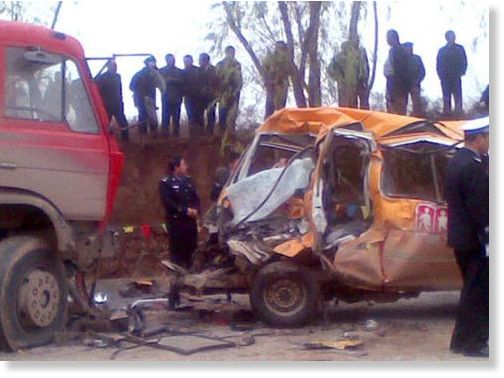
The children were aged 5 and 6, an emergency official said. News of the crash ignited public anger across China, highlighting an underfunded education system that especially shortchanges students in remote areas.
The bus collided head-on with a truck loaded with coal in China's Gansu province, leaving the orange school vehicle crumpled and twisted. Authorities blamed overloading for the accident, the official Xinhua News Agency said.
Five people died at the scene, four children and the bus driver, said the official, surnamed Fan, the director of the emergency office of Gansu provincial work safety bureau. He said the other 14 had died either in hospital or on their way to hospital. The other adult victim was a kindergarten teacher, he said.
Fan said the bus had been carrying 64 people, 62 of whom were children.
The other 45 children were sent to hospital, 13 of them with serious injuries, Xinhua said.
A photo on Xinhua's web site showed the front of the minibus crushed and its sides and roof mangled, while the truck looked relatively undamaged.
The 17 young victims were on their way to Little Doctor Kindergarten in Qingyang city when the accident happened at 9:40 a.m. Xinhua said.
The bus with just nine seats was run by the kindergarten, Xinhua said, citing Li Yuanqing, a press official with Zhengning County government.
A female official from the Zhengning county education bureau said the kindergarten was small and privately run. She would not give her name or position.
"We are doing all we can to reassure the parents," said a local government official, who, like many Chinese would give only his surname, Gao.
Such overcrowding on school buses is common in China, and accidents happen frequently because of poorly maintained vehicles and poor driving habits. State television aired a story in September on a minivan with eight seats that was stopped while carrying 64 preschoolers.
Chinese Twitter-like microblogs exploded with public anger after the latest accident, registering hundreds of thousands of posts within hours of the news.
Many made comparisons to the quality of U.S. school buses, some by attaching a photo purporting to show a Hummer smashed under the rear fender of a school bus in Indianapolis. "Look at American school buses ... Our school buses are irresponsible when it comes to children's lives," ran the heading attached to many posts.
Beijing has made a concerted effort to rebuild and improve a public education system that had withered with the collapse of centrally planned socialism in the 1990s. Central government spending on education has steadily grown in recent years, rising a projected 16 percent this year to $46 billion (296 billion yuan), about three-quarters of it given to local governments.
The overall figures mask great disparities, with rural areas and small cities like Qingyang chronically short of funds. Some local governments lack funds to pay teachers, who in egregious cases have charged parents extra fees to teach their children the required curriculum.
Source: The Associated Press



Reader Comments
to our Newsletter